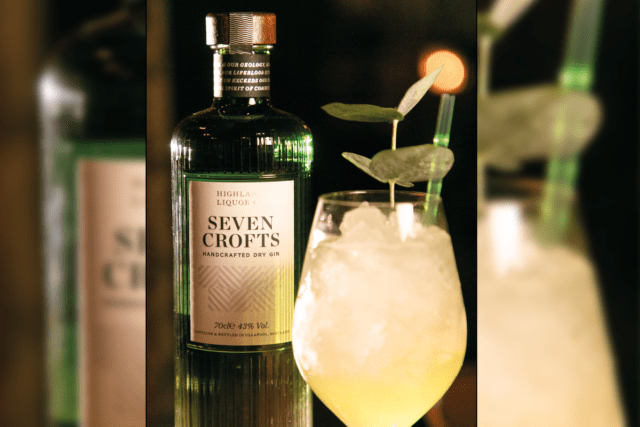Consumers are more knowledgeable after a year of at-home cocktails

WITH customers turning to at-home cocktails and many brand owners recording healthy sales over the past year, it seems even a global pandemic hasn’t managed to dull peoples’ interest in gin.
And with venues reopening and customers returning to the on-trade, gin is likely to be at least as important as it was pre-pandemic.
The popularity of at-home cocktails over the past year is expected to have a knock-on effect on the on-trade in the coming months.
“New at-home drinking habits are set to carry over into the on-trade as restrictions ease and consumers return to their favourite pubs and bars,” said Anne Claypole, category controller at Kopparberg.
“Cocktail serves were a huge trend over lockdown as people tried to recreate the out of home experience in home, with cocktails growing 41% year-on-year and adding £11 million to the category. As lockdown has lifted and we see drinkers heading back to the on-trade, we are continuing to see cocktails as one of the most purchased serves as drinkers are looking for excitement, taste and creation of a serve that is best prepared by a professional bartender.”
This is supported by the fact that, over the past year, customers across the UK have regularly opted for gin-based cocktails when they have been able to visit hospitality venues.
Faith Holland, head of category development at Diageo, said: “The gin category is growing and data from the past year has shown that, on average, 42% of consumers chose cocktails that included gin when spending time in the on-trade.
“Bartenders and consumers alike have been spurred on by this momentum, experimenting with new and innovative flavours, but at the same time becoming discerning with the gins they are choosing to drink or stock.
“In order to capitalise on this, pubs and bars should consider providing a fully rounded, quality gin offering to aid exploration and drive sales on reopening.”
The boom in at-home cocktails is likely to have an impact on the serves customers are ordering when they visit the on-trade.
And with many gin fans having spent the past year learning more about the category and developing a better appreciation of quality cocktails, expectations could be higher than ever.
“In the past year we have seen more and more consumers confidently making a range of cocktails at home using premium gins, other spirits and higher end mixers too,” said Robert Hicks, co-founder of the Highland Liquor Company, producer of gin brand Seven Crofts.
“I would expect cocktails using premium gin as a base spirit to be carried into the on-trade.
“As everyone is looking forward to visiting bars again, a simple serve may be eclipsed by celebratory cocktails as people meet once again with friends and family.”
Ben Stewart, director of UK and European sales at Wemyss Family Spirits, reckoned the tried and tested gin and tonic will remain “a staple favourite”, but expected many venues will see “more adventurous requests on the back of creating our own serves at home over the last four months in lockdown”.
“We have already seen a huge focus on developing outdoor spaces and if the Scottish weather gives us a brief summer then we will see refreshing serves with gin on a lot of the menus in these venues,” said Stewart.
And yet complexity will be less important than quality, reckoned Rob McArdle, marketing controller at Brockmans.
“Cocktails don’t have to be complex, in terms of the number or style of ingredients used, especially when the gin itself offers complexity and distinctiveness,” said McArdle.
“However consumers do now recognise better what it takes to create a great cocktail as opposed to just a good cocktail. They will expect beautifully made and well-garnished drinks from their favourite venues.”
As tends to be the case in the on-trade, looks are likely to matter when it comes to gin serves, and Dale McQueen of McQueen Gin reckoned fruit gins with recognisable flavours will be the order of the day.
“This year you are looking for fruit flavours – pink gin and tropical punches,” said McQueen.
“People want that exotic taste without summer holidays, but they need to know what the flavours are; putting a dragon fruit gin on would simply not sell.”
Appearances are doubly important in the age of social media, when a customer’s Instagram account can provide free marketing for a venue.
“We believe the novelty of customers being able to enjoy themselves within pubs and restaurants will still be prevalent within the on-trade environment in the second half of the year,” said Rosie Milne, business development manager at Eden Mill.
“This may encourage customers to continue to seek out fun and ‘Instagramable’ drinks which they can enjoy in the company of their loved ones.
“Being able to take great pictures of their drinks and share their pictures on social media will still very much be part of the experience as a whole when visiting bars and restaurants going forward.”
For those operators reviewing their gin range, selecting spirits that contrast with each other will be the best approach, according to Claire Murray, director and co-founder of Dunnet Bay Distillers, parent company of Rock Rose Gin.
“Choose a selection of gins that contrast well so that you can suit all your customers’ varying tastes and, if your venue has a cocktail list, create cocktails that feature each of these spirits in the best possible way,” said Murray.
“If space is limited, you only need around five gins to make a good gin menu.
“Don’t just talk to your customers; listen to them as well. Encourage them to drink some of the fine gins neat, initially, as they would a fine whisky, to test what they truly like.
“Then build your list on the feedback you receive.”



















